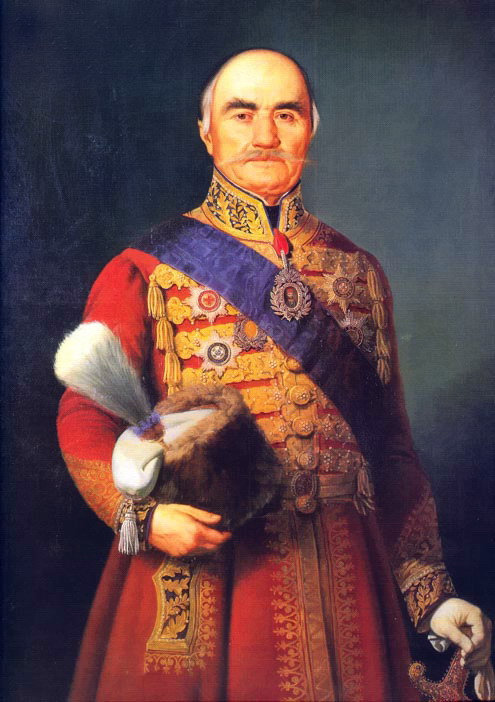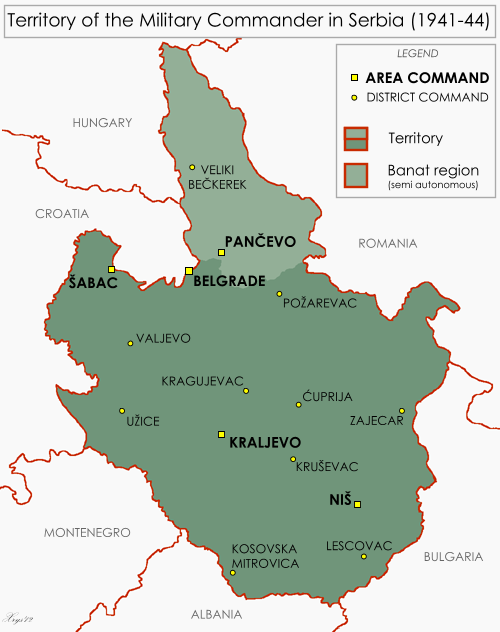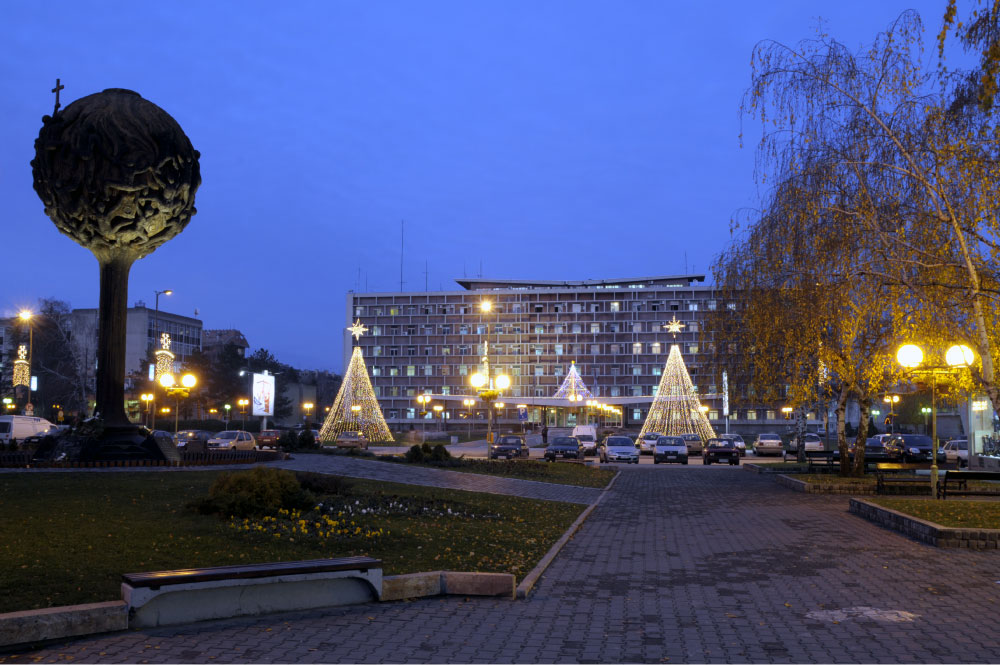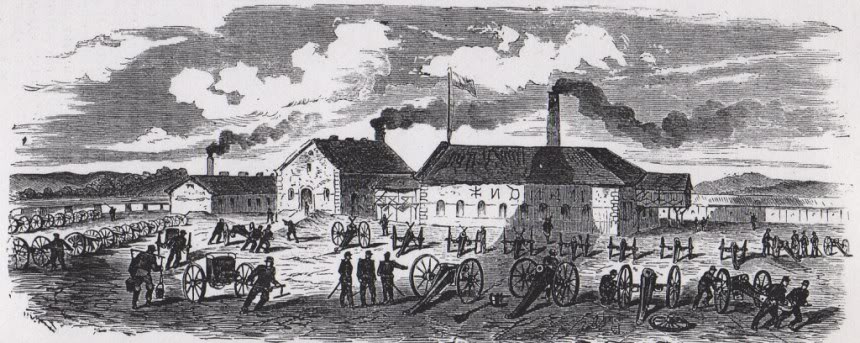|
Kragujevac
Kragujevac ( sr-Cyrl, Крагујевац, ) is the fourth largest city in Serbia and the administrative centre of the Šumadija District. It is the historical centre of the geographical region of Šumadija in central Serbia, and is situated on the banks of the Lepenica River. , the city proper has a population of 150,835, while its administrative area comprises a total of 179,417 inhabitants. Kragujevac was the first capital of modern Serbia and the first constitution in the Balkans, the Sretenje Constitution, was proclaimed in the city in 1838. A unit of the Scottish Women's Hospitals for Foreign Service was located there in World War I. During the Second World War, Kragujevac was the site of a massacre by the Nazis in which 2,778 Serb men and boys were killed. Modern Kragujevac is known for its large munitions (Zastava Arms) and automobile (FCA Srbija) industries, as well as its status as an education centre housing the University of Kragujevac, one of the region's largest ... [...More Info...] [...Related Items...] OR: [Wikipedia] [Google] [Baidu] |
University Of Kragujevac
The University of Kragujevac ( sr, Универзитет у Крагујевцу, Univerzitet u Kragujevcu) is a public university in Kragujevac, Serbia. It is the oldest and the largest higher education institution in Šumadija and Western Serbia. The contemporary centralized university was founded in 1976 and today is organized into 12 constituent faculties. The university offers 118 study programs in the fields of natural sciences and mathematics, social and human sciences, medical sciences, engineering sciences, and arts. As of 2020–21 school year, there are around 14,179 enrolled students on undergraduate, graduate, doctoral, integrated and vocational studies. University of Kragujevac integrates functions of all faculties and organizational units (centers, institutes) in its structure, by implementing unique policy aimed at constant improving of higher education, and improving the quality of teaching, scientific research and artistic development of youth, introductio ... [...More Info...] [...Related Items...] OR: [Wikipedia] [Google] [Baidu] |
Kragujevac Massacre
The Kragujevac massacre was the mass murder of between 2,778 and 2,794 mostly Serb men and boys in Kragujevac, by German soldiers on 21 October 1941. It occurred in the German-occupied territory of Serbia during World War II, and came as a reprisal for insurgent attacks in the Gornji Milanovac district that resulted in the deaths of ten German soldiers and the wounding of 26 others. The number of hostages to be shot was calculated as a ratio of 100 hostages executed for every German soldier killed and 50 hostages executed for every German soldier wounded, a formula devised by Adolf Hitler with the intent of suppressing anti-Nazi resistance in Eastern Europe. After a punitive operation was conducted in the surrounding villages, during which over 400 males were shot and four villages burned down, another 70 male Jews and communists who had been arrested in Kragujevac were killed. Simultaneously, males between the ages of 16 and 60, including high school students, were assembled ... [...More Info...] [...Related Items...] OR: [Wikipedia] [Google] [Baidu] |
Knjaževsko-srpski Teatar
The Princely Serbian Theatre ( sr-cyr, Књажевско-српски театар) is the oldest theatre in Central Serbia. It is based in City of Kragujevac, the fourth largest city of Serbia. The theatre was founded in 1835 by Miloš Obrenović, Prince of Serbia. In the time when theatre was founded, Kragujevac was the first capital of the Principality of Serbia. History Joakim Vujić (1772–1847), writer, translator, foreign languages teacher, theater producer, Director of Knjaževsko Srbski Teatar, the first Serbian Court Theater director in Kragujevac 1835/36. Report on the performance of the first secular play Krestalica in the Theater Rondella in August 1813 in Budapest that translated and organized Joakim Vujić. This performance marked the beginning of the Serbian secular theater. August von Kotzebue (1761–1819) one of the most fruitful German writers seemed to be Vujić favorite playwright for he translated seven Kotzebue's plays. It is renewed after World Wa ... [...More Info...] [...Related Items...] OR: [Wikipedia] [Google] [Baidu] |
FCA Srbija
Fiat Serbia., name=FS — formerly "FIAT Automobiles Serbia"., name=FAS (FAS) from 2008 to 2014, then "FCA Serbia"., name=FCAS (FCAS) until 2021 — is a Serbian automotive manufacturing company based in Kragujevac, Serbia. It is a joint venture (JV) between the ex-Fiat Chrysler Automobiles (FCA), merged into Stellantis in 2021, which owns 67% of the operation, and the Republic of Serbia, which owns the remainder. The company headquarters and assembly plant are located on the former site of Zastava Automobiles (1953-2008) — 70 miles south of Belgrade on the Lepenica river in the country's central Šumadija region. Heavily damaged during the NATO Bombing of Yugoslavia, the factory was completely renovated and modernized, reopening in April 2012 as one of Europe's state of the art car factories. The operation currently has roughly 2,000 employees and works closely with 15 other companies and component suppliers, many located at the adjacent Grosnica Supplier Park &md ... [...More Info...] [...Related Items...] OR: [Wikipedia] [Google] [Baidu] |
List Of Mayors Of Kragujevac
This is a list of presidents of the Municipality of Kragujevac and Mayors of Kragujevac since 1920. The Mayor of Kragujevac is the head of the City of Kragujevac (the fourth largest city in Serbia). He acts on behalf of the city, and performs an executive function in the City of Kragujevac. The current Mayor of Kragujevac is Nikola Dašić ( SNS). Kingdom of Serbs, Croats and Slovenes / Kingdom of Yugoslavia * Vojislav Kalanović (1920 – 1933) * Aleksa Obradović (1933 – 1935) * Kamenko Božić (1935 – 1938) * Dragomir Simović (1938 – 1939) * Miloš Stevović (1939 – 1940) DF Yugoslavia / FPR Yugoslavia / SFR Yugoslavia * Milutin Marković (1944 – 1947) (League of Communists of Yugoslavia) * Milorad Mitrović (1947 – 1949) (League of Communists of Yugoslavia) * Sreten Nikolić (1949 – 1950) (League of Communists of Yugoslavia) * Momir Marković (1950 – 1955) (League of Communists of Yugoslavia) * Momčilo Petrović (1955 – 1957) (League of Communists o ... [...More Info...] [...Related Items...] OR: [Wikipedia] [Google] [Baidu] |
Šumarice Memorial Park
October in Kragujevac Memorial Park ( sr, italic=yes, Spomen-park „Kragujevački oktobar", Спомен-парк „Крагујевачки октобар"), also known as Šumarice Memorial Park (''Memorijalni park Šumarice'', Меморијални парк Шумарице), is the site near Kragujevac, Serbia of the execution of an estimated 2,800 men and boys of the town by the German occupation forces on October 21, 1941, during World War II (Kragujevac massacre). Among the dead were hundreds of high school students. The 21 October Museum was designed by architect Ivan Antić is located at the site of the massacre. Monuments within the park include the monument to the murdered schoolchildren and their teachers (the "Interrupted Flight" monument) by sculptor Miodrag Živković; the "Monument of pain and defiance" by sculptor Ante Gržetić; the "One hundred for one" monument by Nandor Glid; the "Resistance and Freedom" monument by Gržetić; and the Shoeshiners monument (" ... [...More Info...] [...Related Items...] OR: [Wikipedia] [Google] [Baidu] |
Serbia
Serbia (, ; Serbian language, Serbian: , , ), officially the Republic of Serbia (Serbian language, Serbian: , , ), is a landlocked country in Southeast Europe, Southeastern and Central Europe, situated at the crossroads of the Pannonian Basin and the Balkans. It shares land borders with Hungary to the north, Romania to the northeast, Bulgaria to the southeast, North Macedonia to the south, Croatia and Bosnia and Herzegovina to the west, and Montenegro to the southwest, and claims a border with Albania through the Political status of Kosovo, disputed territory of Kosovo. Serbia without Kosovo has about 6.7 million inhabitants, about 8.4 million if Kosvo is included. Its capital Belgrade is also the List of cities in Serbia, largest city. Continuously inhabited since the Paleolithic Age, the territory of modern-day Serbia faced Slavs#Migrations, Slavic migrations in the 6th century, establishing several regional Principality of Serbia (early medieval), states in the early Mid ... [...More Info...] [...Related Items...] OR: [Wikipedia] [Google] [Baidu] |
Šumadija District
The Šumadija District ( sr, / , ) is one of eight administrative districts of Šumadija and Western Serbia. It is located in the central parts of the country. According to the 2011 census results, it has a population of 293,308 inhabitants, and the administrative center is the city of Kragujevac. The district is named after the geographical region of Šumadija. Municipalities The Šumadija District is divided into 6 municipalities and the city of Kragujevac. The municipalities of the district are: * Aranđelovac * Topola * Rača * Batočina * Knić * Lapovo Demographics According to the last official census done in 2011, the Šumadija District had 293,308 inhabitants. 64.9% of the population lived in urban areas. The ethnic composition of the district: Culture and history In the vicinity of Kragujevac stand several medieval monasteries, including the Annunciation monastery Divostin from the thirteenth century; the St. Nicholas monastery, believed to have existed at th ... [...More Info...] [...Related Items...] OR: [Wikipedia] [Google] [Baidu] |
Šumadija And Western Serbia
Šumadija (, sr-Cyrl, Шумадија) is a geographical region in the central part of Serbia. The area used to be heavily covered with forests, hence the name (from ''šuma'' 'forest'). The city of Kragujevac is the administrative center of the Šumadija District in the Šumadija and Western Serbia statistical region. The region is very fertile, and it is known for its extensive fruit production (apples, grapes, plums, etc.). Name ''Šumadija'' received its name from the dense and impassable forests which covered the region, particularly in the 16th and 17th centuries. These forests were preserved until the early 19th century; they are mentioned in literature and tradition. Bertrandon de la Broquière (1400–1459) passed through Serbia, on the road from Palanka to Belgrade he "passed through very large forests". During the reign of Prince Miloš (1817–1839), Serbia was covered with dense forests, through which "no one could walk through, let alone with horse". When Alphonse ... [...More Info...] [...Related Items...] OR: [Wikipedia] [Google] [Baidu] |
Zastava Arms
Zastava Arms ( sr-Cyrl-Latn, Застава oружје, Zastava oružje) is a Serbian manufacturer of firearms and artillery, based in Kragujevac, Serbia. It was founded in 1853 when it cast its first cannon. It is the leading producer of firearms in Serbia and is a large contributor to the local defense industry. Zastava Arms produces and exports a wide variety of products to over forty countries, including the popular Zastava M70, a Kalashnikov rifle. History The successful production of four four-pound cannons and two short howitzers on 27 October 1853 is date of foundation of Zastava Arms in Kragujevac. Between 1856 and 1860, the facilities in Kragujevac received many upgrades to its manufacturing system, eventually allowing the plant to produce weapons with full parts interchangeability. In 1878, one of the main priorities became the modernization of armaments. Serbian rifle „Piboduša“ Model 1870 Peabody became obsolete with their large 14,9mm caliber. After a resear ... [...More Info...] [...Related Items...] OR: [Wikipedia] [Google] [Baidu] |
Šumadija
Šumadija (, sr-Cyrl, Шумадија) is a geographical region in the central part of Serbia. The area used to be heavily covered with forests, hence the name (from ''šuma'' 'forest'). The city of Kragujevac is the administrative center of the Šumadija District in the Šumadija and Western Serbia statistical region. The region is very fertile, and it is known for its extensive fruit production (apples, grapes, plums, etc.). Name ''Šumadija'' received its name from the dense and impassable forests which covered the region, particularly in the 16th and 17th centuries. These forests were preserved until the early 19th century; they are mentioned in literature and tradition. Bertrandon de la Broquière (1400–1459) passed through Serbia, on the road from Palanka to Belgrade he "passed through very large forests". During the reign of Prince Miloš (1817–1839), Serbia was covered with dense forests, through which "no one could walk through, let alone with horse". When Alphonse ... [...More Info...] [...Related Items...] OR: [Wikipedia] [Google] [Baidu] |
List Of Cities In Serbia
, plural: ) is elected through popular vote, elected by their citizens in local elections. Also, the presidents of the municipalities are often referred to as "mayors" in everyday usage. There are 29 cities (, singular: ), each having an assembly and budget of its own. As with a municipality, the territory of a city is composed of a city proper and surrounding villages (e.g. the territory of the City of Subotica is composed of the Subotica town and surrounding villages). The capital Belgrade is the only city on the level of a district. All other cities are on the municipality level and are part of a district. ;City municipalities The city may or may not be divided into ''city municipalities''. Five cities (Belgrade, Niš, Požarevac, Vranje and Užice) comprise several city municipalities. Competences of cities and city municipalities are divided. The city municipalities of these six cities also have their assemblies and other prerogatives. The largest city municipality by number ... [...More Info...] [...Related Items...] OR: [Wikipedia] [Google] [Baidu] |






